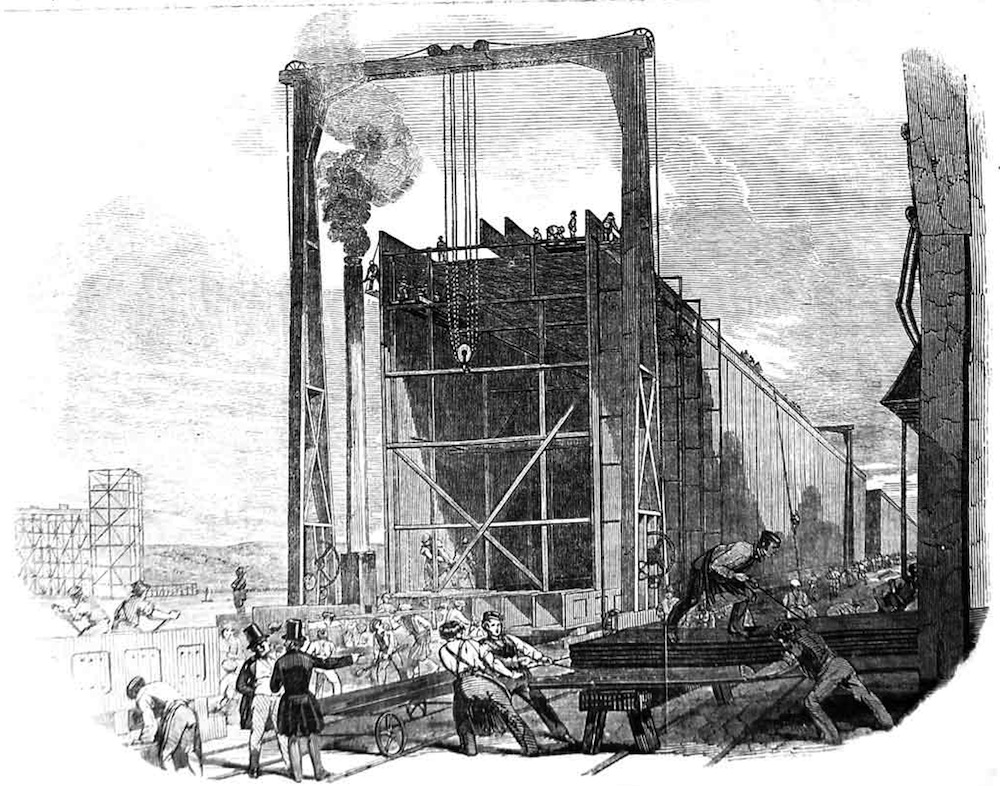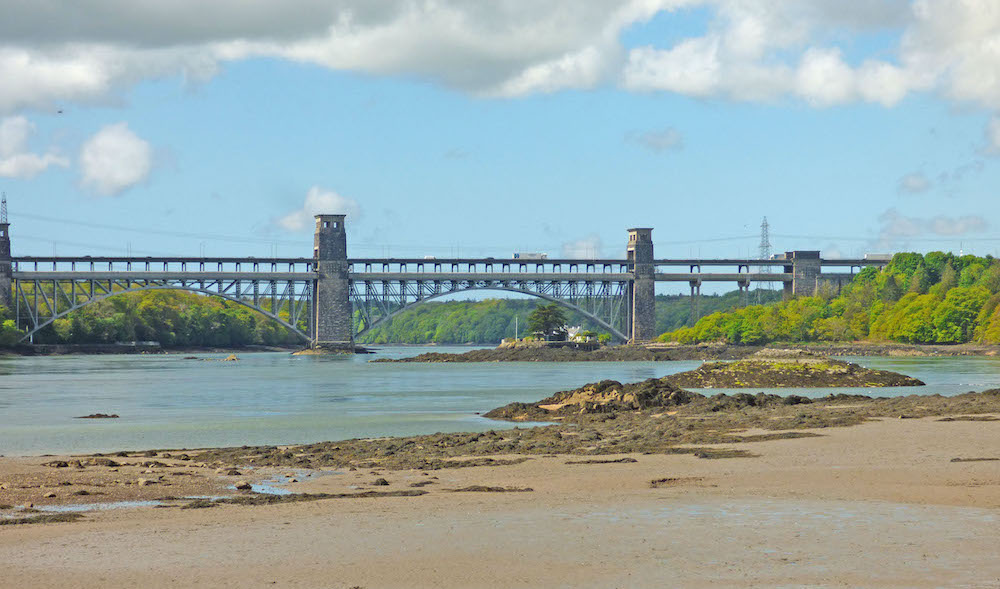
Robert Stephenson's Britannia Bridge across the Menai Straits in North Wales, with Thomas Telford's earlier Menai Bridge in the distance. Source: Black's Picturesque Guide, frontispiece. [Click on this and the following images for larger pictures.]
The Britannia or Tubular Bridge across the Menai Straits, by Robert Stephenson (1803-59). Constructed 1846-50. Originally, as seen here, Stephenson's bridge was a one-deck railway bridge. Its purpose was to provide a rail link for what was then the Chester and Holyhead Railway, between the Welsh mainland and the Isle of Anglesey and, from there, the island's port town of Holyhead for the crossing to northern Ireland. The bridge stands in a beautiful setting, spanning a river "whose currents, marvellous in their colouring as they are vehement in their tides, rush for miles through the narrow channel that separates the leafy and ornate shores of otherwise bleak Anglesey from those of Carnarvon" (Bradley 264), and with the mountains of the Snowdonia National Park in the background.


Left: A cross-section of one of the tubes. Source: Dempsey 102. Right: "Construction of tubes on the Carnarvon shore." Source: "The Britannia Tubular Railway Bridge." Illustrated London News 18 January 1849: 24.
Arches were ruled out here for reasons of shipping access, and George Stephenson opposed the idea of using Thomas Telford's Suspension Bridge for the train service. Subsequently, two other engineers were consulted about the type of new bridge to be built, and eventually the advice taken was that of George Stephenson's friend, Sir William Fairbairn, who contended that a tubular as against a suspension bridge would be strong enough for the purpose: "Provided that the parts are well-proportioned and the plates properly rivetted, you may strip off the chains and have it as a useful Monument of the enterprise and energy of the age in which it was constructed" (qtd. in "Britannia Bridge"). The project went ahead in 1846, twenty years after the opening of Telford's bridge, with Robert Stephenson as chief engineer, and Fairburn himself working on the strengthening of the rectangular tubes through which the trains were to run — he would later claim to have received insufficient credit for this important contribution. According to a contemporary commentary,
The covering of the tubes consists of malleable-iron plates connected together by rivets with ribs of T and L iron, besides strips of flat bar iron over the joints. The top and bottom portions of the tubes are strengthened with internal longitudinal tubes or cells, of which there are eight in the upper part, and six in the lower. The greater number of these cells, and correspondingly increased quantity of metal in the top of the tube, gives greater stiffness and power to resist the crippling or bending, which the experiments showed the weight has a tendency to produce. [Dempsey 102-3]
Further, Stephenson made use of a small island in the middle of the strait to support the middle pier. The resulting three tall towers reflect the original uncertainty about the type of bridge to build: they were even constructed with slots for suspension chains (Brown 64). After all, there was no precedent for this kind of bridge. According to another commentator, the towers detract from its aesthetic appeal (Billington 48), but anyway Stephenson's priority here had to be strength rather than aesthetic appeal. The project was greeted as a "stupendous" one in the Times of 17 August 1847, and finally opened on 5 March 1850. Stephenson, who had previously driven in the very last of two million rivets, was taken across in triumph, in a train "drawn by three locomotives and carrying a thousand people" (Brown 65).

The Britannia Bridge as it is today, by Colin Price.
Apart from the lower sections of the piers, the bridge looks looks very different today. The original was severely damaged by fire in 1970, to the extent that the tube sections had to be dismantled (one narrow section being mounted as a memento on one bank). Steel arches were then used to support a new double-decker crossing for road and rail. The volume of traffic crossing the Menai had, of course, increased phenomenally since Telford's day, and one road crossing was no longer at all adequate. In contrast to Stephenson's own High Level Bridge across the Tyne at Newcastle, the train runs on the lower level here, and vehicles on the higher one.
Beside the ends of the railway level are four great limestone lions carved by the sculptor John Thomas, two on each side, sadly not visible from road level. These had been planned early on: their dimensions are given in the 1847 Times article. Stylised creatures, more like sphinxes than lions, they complement the monolithic Egyptian style of the piers, making an interesting example of Victorian Egyptomania in an unexpected context.

One of the four stone lions sculpted for the bridge in c.1848 by John Thomas (1813-62). Source: a photograph by Velela, at Wikipedia Commons.
Image download and text by Jacqueline Banerjee. The image from the Illustrated London News is reproduced here by kind permission of www.old-print.com. The photograph by Colin Price can be reused without prior permission for any scholarly or educational purpose as long as you (1) credit the photographer, and (2) link your document to this URL in a web document or cite the Victorian Web in a print one. The last photograph is available on the Creative Commons Licence.
Related Material
- The Queen's Visit to the Britannia Tubular Bridge
- Thomas Telford's Menai Bridge
- Egypt, Egyptologists, and Victorian Egyptomania
Sources
Black's Picturesque Guide to North Wales. 5th ed. Edinburgh: A and C Black, 1874. Internet Archive. Contributed by the University of California Libraries. Web. 14 October 2014.
Bradley, A. G. Highways and byways in North Wales. With illustrations by Joseph Pennell and Hugh Thomson. London: Macmillan, 1898. Internet Archive. Contributed by New York Public Library. Web. 14 October 2014.
"Britannia Bridge." Grace's Guide: British Industrial History. Web. 14 October 2014.
"The Britannia-Bridge. The Times. 17 August 1847: 3. Times Digitial Archive. Web. 14 October 2014.
"The Britannia Tubular Railway Bridge." Illustrated London News. 18 January 1849: 24.
Brown, David J. Bridges: Three Thousand Years of Defying Nature. Rev. ed. London: Mitchell Beazley, 1996.
Dempsey, G. Drysdale. Tubular and other iron girder bridges, particularly describing the Britannia and Conway tubular bridges; with a sketch of iron bridges and illustrations of the application of malleable iron to the art of bridge-building. With wood engravings. London: John Weale, 1850. Internet Archive. Contributed by the University of Michigan. Web. 12 April 2014.
Finden, William. The Port, Harbours, Watering Places, and Picturesque Scenery of Great Britain. Illustrated by views taken on the spot. Vol. II. City Road, and Ivy Lane, London: Virtue, 1840. Internet Archive. Contributed by the University of California Libraries. Web. 14 October 2014.
Last modified 14 October 2014